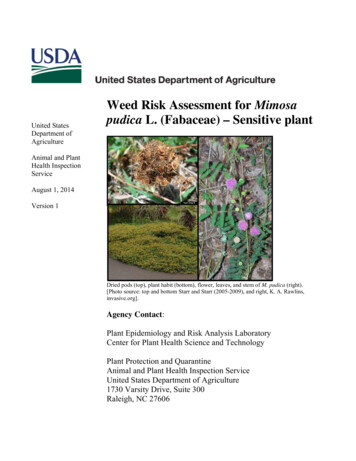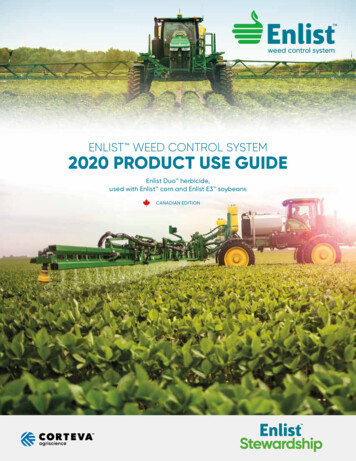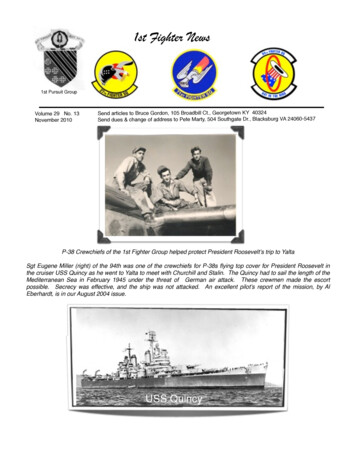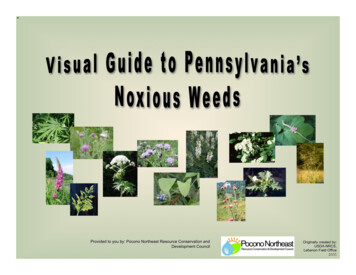
Transcription
United StatesDepartment ofAgricultureWeed Risk Assessment for Mimosapudica L. (Fabaceae) – Sensitive plantAnimal and PlantHealth InspectionServiceAugust 1, 2014Version 1Dried pods (top), plant habit (bottom), flower, leaves, and stem of M. pudica (right).[Photo source: top and bottom Starr and Starr (2005-2009), and right, K. A. Rawlins,invasive.org].Agency Contact:Plant Epidemiology and Risk Analysis LaboratoryCenter for Plant Health Science and TechnologyPlant Protection and QuarantineAnimal and Plant Health Inspection ServiceUnited States Department of Agriculture1730 Varsity Drive, Suite 300Raleigh, NC 27606
Weed Risk Assessment for Mimosa pudicaIntroduction Plant Protection and Quarantine (PPQ) regulates noxious weeds under theauthority of the Plant Protection Act (7 U.S.C. § 7701-7786, 2000) and theFederal Seed Act (7 U.S.C. § 1581-1610, 1939). A noxious weed is definedas “any plant or plant product that can directly or indirectly injure or causedamage to crops (including nursery stock or plant products), livestock,poultry, or other interests of agriculture, irrigation, navigation, the naturalresources of the United States, the public health, or the environment” (7U.S.C. § 7701-7786, 2000). We use weed risk assessment (WRA)—specifically, the PPQ WRA model (Koop et al., 2012)—to evaluate the riskpotential of plants, including those newly detected in the United States,those proposed for import, and those emerging as weeds elsewhere in theworld.Because the PPQ WRA model is geographically and climatically neutral, itcan be used to evaluate the baseline invasive/weed potential of any plantspecies for the entire United States or for any area within it. As part of thisanalysis, we use a stochastic simulation to evaluate how much theuncertainty associated with the analysis affects the model outcomes. We alsouse GIS overlays to evaluate those areas of the United States that may besuitable for the establishment of the plant. For more information on the PPQWRA process, please refer to the document, Background information on thePPQ Weed Risk Assessment, which is available upon request.Mimosa pudica L. – Sensitive PlantSpecies Family: FabaceaeInformation Synonyms: Mimosa andreana Britton & Rose, M. endymionis Martius, M.hirsuta Moçiño & Sessé y Lacasta ex G. Don, Gen., M. hispidula Kunth,M. irritabilis C. Presl, M. pudibunda Willdenow, M. pudica var. glabratade Candolle, M. pudica var. hispida Brenan, M. pudica, var. pastorisBarneby, M. pudica var. tetranda (Humb. & Bonpl. ex Willd.) DC., M.pudica var. unijuga (Duchass. & Walp.) Griseb.), M. tetrandra Humb. &Bonpl. ex Willd., M. unijuga Duch. & Walp. (Francis, 2009; MBG, 2014;Wunderlin and Hansen, 2008). Additional synonyms are listed byWunderlin and Hansen (2008).Common names: Sensitive plant, common sensitive plant, touch-me-not,dormidera (Francis, 2009). Known by many other names in differentlanguages (see Francis, 2009; GISD, 2010; PIER, 2013).Botanical description: Mimosa pudica is a low-sprawling prickly herbaceousshrub or woody herb from 15 to 50 cm high (Barneby, 1991; Francis,2009; Parsons and Cuthbertson, 2001; Holm et al., 1977; Woodson andSchery, 1950). It produces a 1- to 5-seeded fruit pod, edged with pricklesand born in clusters (Parsons and Cuthbertson, 2001). The flowers arepink and clustered in globose heads (Francis, 2009). When the leaves ofM. pudica are touched, it quickly folds its leaflets (Francis, 2009). Referto the following references for a detailed botanical description of theVer. 1August 1, 20141
Weed Risk Assessment for Mimosa pudicataxon: Barneby, 1991; Woodson and Schery, 1950.Initiation: APHIS received a market access request from South Africa forcorn seeds for planting in the United States (South Africa Department ofAgriculture Forestry and Fisheries, 2012). During the development of thatcommodity risk analysis, M. pudica was identified as a weed of potentialconcern to the United States. The PPQ Weeds Cross Functional WorkingGroup requested that PERAL evaluate this species with a weed riskassessment.Foreign distribution: Mimosa pudica is native to tropical America (Holm etal., 1977) from southern Mexico to middle South America (Woodson andSchery, 1950), and the Caribbean (CABI, 2014). It has been widelyintroduced around the world and now has a pan-tropical distribution(Holm et al., 1977), including parts of Africa, Southeast Asia, Australia,and the South Pacific (CABI, 2014).U.S. distribution and status: Mimosa pudica is naturalized in Hawaii (Imada,2012). It has also been reported in the Southeastern United States (Reed,1964; Wunderlin and Hansen, 2008) but its exact status there is not clear.Some records suggest it may be naturalized (Elias, 1974), but othersindicate it is rare to perhaps occurring only as a waif (Weakley, 2010).Mimosa pudica is cultivated to some extent in the United States as acuriosity plant due to its highly touch-sensitive leaves, and has beenreported as a weed in Texas and Louisiana (Dave's Garden, 2000-2014).The seeds of M. pudica are traded in the United States (Amazon.com,2014; CBSC, 2014).WRA area1: Entire United States, including territories.1. Mimosa pudica analysisEstablishment/Spread Mimosa pudica is a perennial plant in warm regions of the world and isPotential often cultivated as an annual in temperate regions (Holm et al., 1977). It hasbeen widely introduced and is now considered a pan-tropical species (Holmet al., 1977). It is widely cultivated as a curiosity due to its highly touchsensitive leaves (Davis and Johnson, n.d.; Dave's Garden, 2000-2014).Mimosa pudica requires disturbed soils to establish (Francis, 2009), and itgrows in full sun or light shade; it is intolerant of heavy shade (Anonymous,2006; Francis, 2009). It reproduces only by seed (Parsons and Cuthbertson,2001). Its pods have stiff marginal bristles, which can attach to wool, fur,and clothing, allowing its dispersal by animals or people (Parsons andCuthbertson, 2001). Seeds are also dispersed by water (Parsons andCuthbertson, 2001) as a contaminant in soil and unspecified agriculturalproduce (UQ, 2011), and as a contaminant of cocopeat, which is used by thenursery industry (James et al., 2011). Mimosa pudica tolerates mowing and1“WRA area” is the area in relation to which the weed risk assessment is conducted [definition modified from that for “PRAarea”] (IPPC, 2012).Ver. 1August 1, 20142
Weed Risk Assessment for Mimosa pudicaburning, and repeated burning may promote its spread in pastures (CABI,2014; Francis, 2009). We had low uncertainty in this risk element.Risk score 17Uncertainty index 0.11Impact Potential Mimosa pudica is most commonly reported as a weed of pastures (CABI,2014), lawns (Dave's Garden, 2000-2014; Urban Forest, 2014), and severalcrops, including maize, sugarcane, rubber, tea, sorghum, soybeans, andupland rice (Parsons and Cuthbertson, 2001). In Queensland, Australia, it isregarded more as a nuisance than a serious weed (Parsons and Cuthbertson,2001). In contrast, in Fiji it is highly regarded as a forage plant for dairyproduction (Holm et al., 1977). Cattle and sheep accept and graze on M.pudica (Wahab, 2001; Simonnet, 1990). Although seeds and other plantparts of M. pudica contain mimosine, an amino acid that can cause hair lossand depressed growth in mammals (in Francis, 2009), we found nosignificant evidence of animal impacts. Francis (2009) reports that a largedose is necessary to cause problems. While farm practices keep M. pudicaunder control in arable land, chemical control is more appropriate in grazingareas and plantation crops (Parsons and Cuthbertson, 2001). We had anaverage level of uncertainty in this risk element.Risk score 2.9Uncertainty index 0.20Geographic Potential Based on three climatic variables, we estimate that about 22 percent of theUnited States is suitable for the establishment of Mimosa pudica (Fig. 1).This predicted distribution is based on the species’ known distributionelsewhere in the world and includes point-referenced localities and areas ofoccurrence. The map for M. pudica represents the joint distribution of PlantHardiness Zones 7-13, areas with 10-100 inches of annual precipitation,and the following Köppen-Geiger climate classes: tropical rainforest,tropical savanna, humid subtropical, and marine west coast.The area estimated likely represents a conservative estimate as it only usesthree climatic variables. Other environmental variables, such as soil andhabitat type, may further limit the areas in which this species is likely toestablish. Mimosa pudica occurs mainly in highly disturbed systems, likecroplands, orchards, pastures, roadsides, home gardens, lawns, constructionsites, and waste places close to urban areas (Anonymous, 2013a; Francis,2009; Parsons and Cuthbertson, 2001).Entry Potential We did not assess the entry potential of Mimosa pudica because it is alreadypresent in the United States (Imada, 2012; Reed, 1964; Wunderlin andHansen, 2008).Ver. 1August 1, 20143
Weed Risk Assessment for Mimosa pudicaFigure 1. Predicted distribution of Mimosa pudica in the United States. Mapinsets for Alaska, Hawaii, and Puerto Rico are not to scale.2. Results and ConclusionModel Probabilities: P(Major Invader) 83.4%P(Minor Invader) 16%P(Non-Invader) 0.6%Risk Result High RiskSecondary Screening Not applicableVer. 1August 1, 20144
Weed Risk Assessment for Mimosa pudica5 Species Risk ScoreInvasive ct Potential4.543.53Risk Rating High Risk Evaluate Further Low ment Spread PotentialFigure 2. Mimosa pudica risk score (black box) relative to the risk scores ofspecies used to develop and validate the PPQ WRA model (other symbols).See Appendix A for the complete assessment.EvaluateFurtherLow Risk5High RiskImpact Potential4.54Species Risk Score3.5Simulated Risk %1‐20‐15‐10‐50510152025Establishment Spread PotentialFigure 3. Model simulation results (N 5,000) for uncertainty around therisk score for Mimosa pudica. The blue “ ” symbol represents the mediansof the simulated outcomes. The smallest box contains 50 percent of theoutcomes, the second 95 percent, and the largest 99 percent.Ver. 1August 1, 20145
Weed Risk Assessment for Mimosa pudica3. DiscussionThe result of the weed risk assessment for M. pudica is High Risk (Fig. 2).Overall, we had low uncertainty and our conclusion was well supported by theresults of the uncertainty simulation (Fig. 3). Thus, even if some of the answers inthe assessment were to change based on new evidence, the result of theassessment is likely to still be High Risk. An evaluation of M. pudica with theAustralian Weed Risk Assessment gave similar conclusions (Gordon et al., 2008;Gordon, 2010).It is not clear how widespread M. pudica is in the continental United States.Anecdotal information (Dave's Garden, 2000-2014; Elias, 1974; Rawlins, 2009)suggests that M. pudica has a wider U.S. distribution than herbarium recordsindicate (e.g., Wunderlin and Hansen, 2008). However, this plant is limited tohighly disturbed areas (Francis, 2009). Managers should be aware that because M.pudica is a curiosity plant due to its highly touch-sensitive leaves, seeds arecommercially available (Amazon.com, 2014; CBSC, 2014) and traded by plantenthusiasts (Dave's Garden, 2000-2014) in the United States.4. Literature Cited7 CFR § 360. 2013. Code of Federal Regulations, Title 7, Part 360, (7 CFR §360 Noxious Weed Regulations). Office of the Federal Register, NationalArchives and Records Administration, Washington, DC.7 U.S.C. § 1581-1610. 1939. The Federal Seed Act, Title 7 United States Code §1581-1610.7 U.S.C. § 7701-7786. 2000. Plant Protection Act, Title 7 United States Code §7701-7786.Amazon.com. 2014. Search: Seeds Mimosa pudica. Last accessed March 20,2014, www.amazon.com.Anonymous. 2006. Mimosa pudica L. Tropical Biology h/dip/species/Mimosa%20pudica.htm. (Archived atPERAL).Anonymous. 2013a. Common sensitive plant, Mimosa pudica. Fact Sheet PestPlant PP38. Department of Agriculture, Fisheries and Forestry,Biosecurity Queensland, Australia.http://www.daff.qld.gov.au/ data/assets/pdf .Anonymous. 2013b. Invasive Plant Atlas of the United States.http://www.invasiveplantatlas.org. (Archived at PERAL).APHIS. 2014. Phytosanitary Export Database (PExD). United States Departmentof Agriculture, Animal and Plant Health Inspection Service ortFormat.jsp. (Archived atPERAL).Barneby, R. C. 1991. Sensitive censitae: A description of the genus MimosaLinnaeus (Mimosaceae) in the New World. Memoirs of the New YorkVer. 1August 1, 20146
Weed Risk Assessment for Mimosa pudicaBotanical Garden 65:835 pp.CABI. 2014. Invasive Species Compendium. Commonwealth Agricultural BureauInternational (CABI). http://www.cabi.org/isc/. (Archived at PERAL).Carter, K. 2010. Mimosa pudica plants. Gardenguides.com. Last accessed March19, 2014, ants.html.CBSC. 2014. Online catalog. Carolina Biological Supply Company (CBSC). Lastaccessed March 25, 2014, http://www.carolina.com/.Chandra, G., A. Ghosh, D. Biswas, and S. N. Chatterjee. 2006. Host plantpreference of Mansonia mosquitoes. Journal of Aquatic PlantManagement 44:142-144.Chauhan, B. S., and D. E. Johnson. 2009. Germination, emergence, and dormancyof Mimosa pudica. Weed Biology and Management 9(1):38-45.Cheng, J.-z. 2011. Effect of Mimosa bimucronata leaves water extracts on seedsgermination of three cultivated species [Abstract]. Journal of AnhuiAgricultural Sciences 30.Chieng, H.-T., and T. C. Huang. 1998. Aeropollen of the Pingtung area, SouthTaiwan. Taiwania 43(2):73-100.Cunanan-Deyto, R. A., A. C. Manila-Fajardo, and C. R. Cervancia. 2012. Pollencontents of Apis mellifera Linn. honey from Davao city, Philippines.Journal of Nature Studies 11(1 & 2):96-102.Dave's Garden. 2000-2014. Plant Files: Touch-me-not, Tickleme Plant, Tickle MePlant, Sensitive Plant, Humble Plant, Mimosa pudica. Last accessedMarch 19, 2014, http://davesgarden.com/guides/pf/go/2573/.Davis, S., and N. Johnson. n.d. Mimosa pudica (sensitive plant). Royal BotanicalGardens, Kew. Last accessed March 18, s-fungi/mimosa-pudicasensitive-plant.DiSalvo, C. 2010. Integrated Pest Management Manual: Exotic Weeds II. UnitedStates Department of the Interior, National Park al/exweeds2.cfm.Ebay. 2014. Search: Mimosa pudica eBay Inc. http://www.ebay.com/. (Archivedat PERAL).Elias, T. 1974. The genera of Mimosoideae (Leguminosae) in the SoutheasternUnited States. Journal of the Arnold Arboretum 55(1):67-118.Ferreira, E. G. B. d. S., V. P. Matos, L. H. d. M. Sena, and A. G. d. F. A. Sales.2010. Efeito alelopático do extrato aquoso de sabiá na germinação desementes de fava [Allelopathic effect of aqueous extract of Mimosacaesalpiniaefolia Benth. in seed germination of Phaseolus lunatus].Revista Ciência Agronômica 41(3):463-467.Francis, J. K. 2009. Mimosa pudica L., sensitive plant FABACEAE. WildlandShrubs of the United States and its Territories: Thamnic Descriptions.General Technical Report IITF-WB-1. U.S. Department of Agriculture,Forest Service, International Institute of Tropical Forestry and ShrubSciences nd shrubs.htm.Ver. 1August 1, 20147
Weed Risk Assessment for Mimosa pudicaGISD. 2010. Mimosa pudica. Global Invasive Species Database p?si 1002&fr 1&sts &lang EN. (Archived at PERAL).Gordon, D. R. 2010. Weed risk assessments for Florida for The NatureConservancy. Hawaiian Ecosystems at Risk project (HEAR).http://www.hear.org/wra/tncflwra/. (Archived at PERAL).Gordon, D. R., D. A. Onderdonk, A. M. Fox, R. K. Stocker, and C. Gantz. 2008.Predicting Invasive Plants in Florida Using the Australian Weed RiskAssessment. Invasive Plant Science and Management 1(2):178-195.Hacker, J. B. 1990. A Guide to Herbaceous and Shrub Legumes of Queensland.University of Queensland Press, St. Lucia, Queensland, Australia.Heap, I. 2014. The international survey of herbicide resistant weeds. WeedScience Society of America. www.weedscience.com. (Archived atPERAL).Heide-Jorgensen, H. S. 2008. Parasitic Flowering Plants. Brill, Leiden, TheNetherlands. 438 pp.Holm, L. G., D. L. Plucknett, J. V. Pancho, and J. P. Herberger. 1977. TheWorld's Worst Weeds: Distribution and Biology. Krieger PublishingCompany, Malabar, Florida, U.S.A. 69 pp.Imada, C. 2012. Hawaiian Native and Naturalized Vascular Plants Checklist(December 2012 update). Bishop Museum Technical Report 60, Honolulu,Hawaii. pdf.IPPC. 2012. International Standards for Phytosanitary Measures No. 5: Glossaryof Phytosanitary Terms. Food and Agriculture Organization of the UnitedNations, Secretariat of the International Plant Protection Convention(IPPC), Rome, Italy.James, T. K., P. D. Champion, M. Bullians, and A. Rahman. 2011. Weedbiosecurity breach through coco peat imports. R. McFadyen, N.Chandrasena, S. Adkins, A. Hashem, S. Walker, D. Lemerle, L. Weston,and S. G. Lloyd, (eds.). Twenty-Third Asian-Pacific Weed ScienceSociety Conference, The Sebel Cairns, Queensland, Australia.Joseph, K., and T. K. Bridgit. 1993. Effect of chemical and integrated weedmanagement in upland rice [Abstract]. Journal of Tropical Agriculture31(1):77-80.Koop, A., L. Fowler, L. Newton, and B. Caton. 2012. Development and validationof a weed screening tool for the United States. Biological Invasions14(2):273-294.Liogier, H. A., and L. F. Martorell. 2000. Flora of Puerto Rico and adjacentislands: a systematic synopsis (2nd ed.). Editorial de la Universidad thePuerto Rico, San Juan, Puerto Rico.Mabberley, D. J. 2008. Mabberley's Plant-Book: A Portable Dictionary of Plants,Their Classification and Uses (3rd edition). Cambridge University Press,New York. 1021 pp.Mandal, R. C. 1977. Effect of newer herbicides on weeds in dry and wetland ricein Fiji [Abstract]. Program and Abstracts of Papers, Weed ScienceConference and Workshop in India,Ver. 1August 1, 20148
Weed Risk Assessment for Mimosa pudicaMBG. 2014. Tropicos.org. Missouri Botanical Garden (MBG).http://www.tropicos.org. (Archived at PERAL).Mori, S., and J. Brown. 1998. Epizoochorous dispersal by barbs, hooks, andspines in a lowland moist forest in central French Guiana. Brittonia50(2):165-173.Motooka, P., L. Castro, D. Nelson, G. Nagai, and L. Ching. 2003. Weeds ofHawai'i's Pastures and Natural Areas: An Identification and ManagementGuide. College of Tropical Agriculture and Human Resources, Universityof Hawai'i at Manoa, Honolulu, HI, U.S.A. 184 pp.Muthuramkumar, S., N. Ayyappan, N. Parthasarathy, D. Mudappa, T. R. S.Raman, M. A. Selwyn, and L. A. Pragasan. 2006. Plant CommunityStructure in Tropical Rain Forest Fragments of the Western Ghats, India.Biotropica 38(2):143-160.Nickrent, D. 2012. Parasitic plant classification. Southern Illinois UniversityCarbondale, Carbondale, IL, U.S.A. Last accessed March 3, tes.html.NRCS. 2014. The PLANTS Database. United States Department of Agriculture,Natural Resources Conservation Service (NRCS), The National Plant DataCenter. http://plants.usda.gov. (Archived at PERAL).Opler, P. A., W. F. Gordon, and H. G. Baker. 1980. Comparative PhenologicalStudies of Treelet and Shrub Species in Tropical Wet and Dry Forests inthe Lowlands of Costa Rica. Journal of Ecology 68(1):167-188.Page, S., and M. Olds (eds.). 2001. The Plant Book: The World of Plants in aSingle Volume. James Mills-Hicks, Australia. 1020 pp.Parsons, W. T., and E. G. Cuthbertson. 2001. Noxious Weeds of Australia(Second). CSIRO Publishing, Collingwood. 698 pp.Partridge, I. J. 1986. Effect of stocking rate and superphosphate level on anoversown fire climax grassland of mission grass (Pennisetumpolystachyon) in Fiji. I. Botanical composition of pasture. TropicalGrasslands 20(4):166-173.Payawal, P. C., A. L. Manimtim, and A. C. Tilde. 1988. Year round pollensources of the Italian honeybees (Apis mellifera L.) in the Philippines; 1:Los Baños area [Abstract]. Philippine Agriculturist 69:217-225.Payawal, P. C., A. C. Tilde, and A. L. Manimtim. 1991. Year round pollensources of Italian honey bees (Apis mellifera L.) in the Philippines. III.Selected areas. Philippine Agriculturist 74(4):503-509.PIER. 2013. Pacific Island Ecosystems at Risk (PIER). United States ForestService. http://www.hear.org/pier/. (Archived at PERAL).Pokhriyal, T. C., H. C. S. Bhandari, D. S. Negi, S. P. Chaukiyal, and B. B. Gupta.1990. Identification of some fast growing leguminous tree species fornitrogen fixation studies. Indian Forester 116(6):504-507.Randall, R. P. 2012. A Global Compendium of Weeds, 2nd edition. Departmentof Agriculture and Food, Western Australia, Perth, Australia. 1107 pp.Rawlins, K. A. 2009. Sensitive plant, Mimosa pudica L. Invasive.org. Lastaccessed http://www.invasive.org/browse/detail.cfm?imgnum 5406709.Reed, C. F. 1964. The flora of the chrome and manganese ore piles at Canton, inVer. 1August 1, 20149
Weed Risk Assessment for Mimosa pudicathe port of Baltimore, Maryland and at Newport News, Virginia, withdescriptions of genera and species new to the flora of Eastern UnitedStates. Phytologia 10(5):321-406.Roubik, D., S. Sakai, and A. A. Hamid (eds.). 2005. Pollination Ecology and theRain Forest: Sarawak Studies. Springer Science Business Media, Inc.,New York.Shelton, H. M., L. R. Humphreys, and C. Batello. 1987. Pastures in theplantations of Asia and the Pacific: Performance and prospect. TropicalGrasslands 21(4):159-168.Simonnet, P. 1990. Sheep flock management in a tropical environment undercoconut [Abstract]. Oleagineux 45(10):451-456.South Africa Department of Agriculture Forestry and Fisheries. 2012. Request formarket access for maize (Zea mays) seeds for planting from South Africainto the USA. South Africa Department of Agriculture Forestry andFisheries, Directorate of Plant Health, Pretoria, South Africa.Space, J. C., and T. Flynn. 2000. Observations on invasive plant species inAmerican Samoa. USDA Forest Service, Honolulu, tm#m-native. 51 pp.Starr, F., and K. Star. 2005-2009. Plants of Hawaii: Mimosa pudica. om/images/search/?q Mimosa pudica&o plants. (Archived at PERAL).Swearingen, J. M. 2008. Survey of Invasive Plants Impacting National Parks inthe United States. Invasive Plant Atlas of the United .pdf.Uddin, K., A. D. Juraimi, M. R. Ismail, and J. T. Brosnan. 2010. Characterizingweed populations in different turfgrass sites throughout the Klang Valleyof western Peninsular Malaysia. Weed Technology 24:173-181.UQ. 2011. Environmental Weeds of Australia, Biosecurity Queensland Edition.The University of Queensland (UQ) / Queensland Government Australia.Last accessed March 13, osa pudica.htm.Urban Forest. 2014. Urban Forest: An identification guide to the flora ofSingapore and Southeast Asia. Last accessed March 19, 2014,http://uforest.org/Species/M/Mimosa pudica.html.Wahab, H. A. 2001. Forages in Oil Palm and Rubber Plantations in Malaysia.7thMeeting of the Regional Working Group on Grazing and Feed Resources.Forage Development in Southeast Asia: Strategies and Impacts. 2-7 July,Manado, edings/manado/chap4.htmWalker, R. 2014. Parasitic Plants Database.http://www.omnisterra.com/bot/pp home.cgi. (Archived at PERAL).Weakley, A. S. 2010. Flora of the Carolinas, Virginia, Georgia, Northern Florida,and Surrounding Areas (2010 draft). University of North CarolinaHerbarium, Chapel Hill, NC, U.S.A. 994 pp.Ver. 1August 1, 201410
Weed Risk Assessment for Mimosa pudicaWood, S. H., A. D. Ziegler, and T. Bundarnsin. 2008. Floodplain deposits,channel changes and riverbank stratigraphy of the Mekong River area atthe 14th-Century city of Chiang Saen, Northern Thailand. Geomorphology101:510-523.Woodson, R. E., Jr., and R. W. Schery. 1950. Flora of Panama. Part V. Fascicle II(Resedaceae to Leguminosae, in part). Annals of the Missouri BotanicalGarden 37(2):121-314. http://botanicus.org/page/1386927.Wunderlin, R. P., and B. F. Hansen. 2008. Atlas of Florida Vascular Plants.Institute for Systematic Botany, the University of South Florida and theFlorida Center for Community Design Researchhttp://www.florida.plantatlas.usf.edu/. (Archived at PERAL).Ver. 1August 1, 201411
Weed Risk Assessment for Mimosa pudicaAppendix A. Weed risk assessment for Mimosa pudica L. (Fabaceae). The following information camefrom the original risk assessment, which is available upon request (full responses and all guidance). Wemodified the information to fit on the page.Question IDAnswer ScoreUncertaintyESTABLISHMENT/SPREAD POTENTIALES-1 (Status/invasivenessf - negl5outside its native range)ES-2 (Is the species highlydomesticated)n - low0ES-3 (Weedy congeners)y - negl1ES-4 (Shade tolerant atsome stage of its life cycle)n - high0ES-5 (Climbing orsmothering growth form)n - negl0ES-6 (Forms dense thickets) y - low2Ver. 1Notes (and references)Mimosa pudica is native to tropical America (Holm et al., 1977) fromsouthern Mexico to middle South America (Woodson and Schery,1950), and the Caribbean (CABI, 2014). It has been widelyintroduced and is now pan-tropical (Holm et al., 1977). Mimosapudica L. var. unijuga (Duchass. & Walp.) Griseb. is naturalized inthe Hawaiian Islands of Nihau, Kauai, Oahu, Molokai, Lanai, Maui,and Hawaii (Imada, 2012). In American Samoa, it is a "widespreadweedy species" (Space and Flynn, 2000). "The sensitive plant iswidely distributed in the tropics, . invading forestry plantations,croplands, orchards and pastures throughout the tropics, especially inSouth Asia, the Pacific Islands and some African countries" (Davisand Johnson, n.d.). Alternate answers for the Monte Carlo simulationare both “e.”Mimosa pudica is often grown as an annual (Holm et al., 1977). "Thesensitive plant is popular in cultivation around the world, and isenjoyed by many as a curiosity due to its highly touch-sensitiveleaves" (Davis and Johnson, n.d.). "M[imosa] pudica var. hispida,which originates from southwest Mexico, is the most popularlycultivated variety" (Davis and Johnson, n.d.). "Mimosa pudica hasbeen used widely in traditional medicine" in Republic of the Congo,Senegal, India (Davis and Johnson, n.d.). However, we found noevidence that it has been bred for any particular traits resulting inreduced weed potential.The genus Mimosa contains 510 species (Mabberley, 2008). A fewdozen of these species are considered weeds (Randall, 2012). Mimosainvisa (syn. M. diplotricha) and M. pigra are listed as U.S. FederalNoxious Weeds (7 CFR § 360, 2013).We found conflicting evidence regarding the shade tolerance of thisplant. One source stated it can stand considerable shading (Holm etal., 1977; see references therein), and another categorized it as a highshade tolerant legume (Shelton et al., 1987). In contrast, other sourcescharacterized it as "shade intolerant and does not compete with tallvegetation or grow under forest canopies" (Francis, 2009), and "Fullsun or light shade, intolerant of heavy shade" (Anonymous, 2006).Based on those descriptions, the species’ overall habitat (primarilyopen disturbed areas) (Francis, 2009), and its cultivationrequirements (full sun) (Page and Olds, 2001), we answered no.Mimosa pudica is not a vine and does not form rosettes. This plant isa short, herbaceous shrub with stems ascending or growing along theground (prostrate) (Francis, 2009). "Has an un upright or low trailinghabit, from 20 to 100 cm in height" (Holm et al., 1977).Mimosa pudica ".may grow as a single plant or in tangled thickets"(GISD, 2010). In Thailand, "[v]alleys are mostly in rice paddies orare seasonally swampy areas covered with impenetrable thickets ofthorny mimosa shrub (Mimosa pudica) Uncultivated riparian areasare commonly covered by. thickets of thorny mimosa" (Wood et al.,2008).August 1, 201412
Weed Risk Assessment for Mimosa pudicaQuestion IDAnswer Uncertaintyn - lowScoreNotes (and references)0ES-8 (Grass)ES-9 (Nitrogen-fixingwoody plant)n - negln - low00ES-10 (Does it produceviable seeds or spores)y - negl1ES-11 (Self-compatible orapomictic)ES-12 (Requires specialpollinators)y - low1Mimosa pudica occurs " as a weed of cultivated fields, roadsides,home gardens, and waste places close to urban areas" (Parsons andCuthbertson, 2001). Common sensitive plant occurs in disturbed andcultivated areas, such as roadsides, vacant allotments, heavily grazedpastures, crops, and lawns (Anonymous, 2013a). "Sensitive plantgrows in most well drained soils." (Francis, 2009). In contrast,"[t]he aquatic plants.Mimosa pudica were collected from shallowfreshwater ponds and rice fields at Burdwan [India]" (Chandra et al.,2006). Although one source indicates this species may grow inshallow freshwater ponds, this species is primarily a terrestrial shrub,thus we answer no.Mimosa pudica is a legume in the Fabaceae family (Francis, 2009).While M. pudica forms root nodules that exhibit nitrogen-fixingactivity (Pokhriyal et al., 1990), M. pudica is described as a “shrub”or “woody herb” by one worker (Francis, 2009), and as a herbaceousshrub by others (Barneby, 1991; Holm et al., 1977; Parsons andCuthbertson, 2001; Woodson and Schery, 1950). Based on thisspecies’ overall habitat, for the purpose of this question weconsidered it as an herbaceous or semi-woody species, answering no.Mimosa pudica "reproduces by seeds freshly
United States Department of Agriculture Animal and Plant Health Inspection Service August 1, 2014 Version 1 Weed Risk Assessment for Mimosa pudica L. (Fabaceae) - Sensitive plant Dried pods (top), plant habit (bottom), flower, leaves, and stem of M. pudica (right). [Photo source: top and bottom Starr and Starr (2005-2009), and right, K. A. Rawlins,










